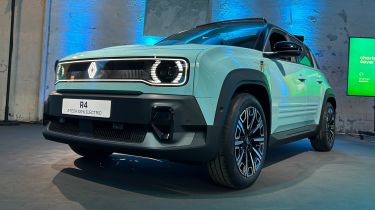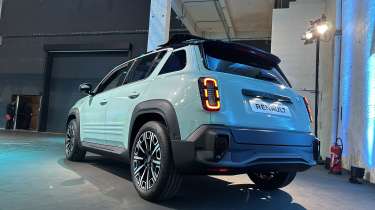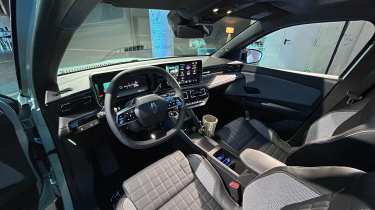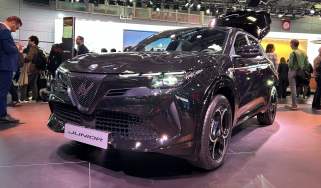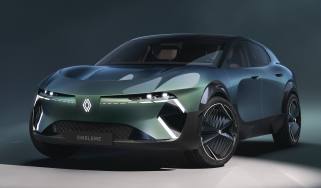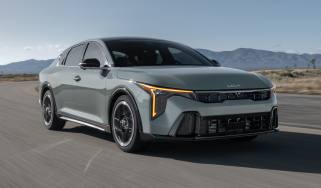New Renault 4 is another retro-inspired icon for the EV era
Following in the footsteps of the hotly anticipated Renault 5, the 4 adds a dose of practicality and some SUV style
While the all-new Renault 5 has been busy living up the last few months in the spotlight, its more sensible sister car – the electric Renault 4 compact SUV – has been waiting in the wings, ready to capitalise on the brand’s retro renaissance.
Inspired by the R4 of the sixties, as well as the 4EVER Trophy concept from 2022, the car you see here – and of which we were treated to a hands-on unveiling last week with chief designer Giles Vidal – has now been revealed in full at the Paris Motor Show.
Stacking up against big-name rivals such as the Peugeot E-2008 and Vauxhall Mokka, as well the reigning Auto Express Car of the Year, the Citroen e-C3, the Renault 4 will dive head-first into the strongly contested B-segment electric-SUV market. It’ll soon face tough competition from the hotly anticipated MINI Aceman and Ford Puma Gen-E, too.
Despite sharing its AmpR Small platform with the 5, the 4.14-metre Renault 4 is 220mm longer than its sibling, with 80mm of that in the longer wheelbase. The 4 is roughly as wide as the 5, but fractionally taller; the newer model’s 420-litre boot (1,400 litres with the seats down) and more spacious rear bench mean it’s unquestionably the more practical of the pair.
With plenty of aesthetic nods to the original – which sold over eight million units globally during its 33-year production run – the 4 has been modernised for the electric era. “The [R4] has to be cool and interesting for what it is,” Vidal told us. “We had to stay true to the mission of the Renault 4”.
Yet despite the new 4’s inherent functionality and nostalgic appeal, Renault’s design projects director Paula Fabregat-Andreu told us the 4 had to “seduce a new generation” not familiar with the original. As such, the nose has been “modernised” with a set of recognisable rounded headlights with integrated DRLs, plus the “world’s first” one-piece illuminated grille.
Proportionally, the car mimics the form of its predecessor with its flat front end, upright stance and sloping tailgate that opens low to preserve the ease of access. A broad shoulder line, small, elongated tail-lights and a roof spoiler complete the new car’s look.
Inside, at least up front, the 4 will feel familiar to anyone who’s sat in the new Renault 5. The tech offering comprises a pair of digital displays, with the main 10-inch screen powered by the firm’s Google-based infotainment system. This set-up supports Apple CarPlay and Android Auto, as well as a number of third-party apps, and can be updated over the air. Beneath the main display sits a pair of vents, plus a row of easy-to-access shortcut buttons for the climate control.
Perceived quality is, by and large, excellent. Like the 5, the 4 gets plenty of soft fabrics but durable materials on the seats, doors and dashboard, which means you’ll need to go intentionally searching to find anything particularly harsh or abrasive – despite Vidal claiming his team’s brief was to make the car “life proof”. The model we sat in had a back-lit panel with the Renault 4 logo in it, as well as a baguette holder that clips to the centre console – first seen in the 5 earlier this year. This is a car designed, in no uncertain terms, to celebrate its French history and heritage.
Cabin storage is a bit of a mixed bag, with a shallow tray and a couple of USB-C ports just below the electronic parking brake, plus a deeper section running along the centre console which can be filled with 3D-printed dividers or themed covers. A small lidded cubby between the front seats is big enough for your phone or wallet, but little else.
Move into the back and you’ll find enough space for a six-foot-tall adult to just about sit behind a similarly sized driver – albeit with their legs raised slightly due to the high floor. That floor is flat, however, so you’ll be able to get three people back there for short journeys – two of whom will be able to charge their devices thanks to another pair of USB slots. Quality isn’t noticeably poorer in the rear, although the doors close with a bit less of a thunk.
Because the Renault 4 shares its platform with the 5, it’s no surprise to learn the tech buried within is identical. Despite the slightly longer wheelbase, the psuedo-SUV will be offered with the same 40kWh (Urban) and 52kWh (Comfort) batteries – the latter of which has a predicted official range of “up to 249 miles” – slightly down on the 5’s 252-mile maximum. The 4’s smaller, more affordable battery set-up has a range “greater than 186 miles”, according to the manufacturer.
If you step up to the so-called ‘Comfort’ version, you also get a more powerful motor. Here, the base car’s 118bhp/225Nm front-drive layout is upgraded to a single motor pushing out 148bhp/245Nm – allowing for 0-62mph in less than 8.5 seconds. It also gets faster charging; 80kW in the ‘Urban’ model plays 100kW in the ‘Comfort’ car. The big-battery 5 can go from 15-80 per cent in around 30 minutes and Renault has confirmed the 4 can complete this benchmark in the same time. The small SUV also supports vehicle-to-load (V2L) and vehicle-to-grid (V2G) charging.
In addition, Renault claims the 4 will feature “no fewer than 26 driving aids”, as well as the My Safety switch found on several of the maker’s other models – allowing drivers to personalise the safety systems and program them through a single button.
Renault has also confirmed that the 4 will be the first of its cars to feature one-pedal driving. This setting maximises the car’s regenerative braking – one of three modes accessed via the steering-wheel paddles – and can bring the car to a complete stop. Whether this will be added to the R5 via an OTA update remains to be seen.
Prices haven’t been announced, but we’ve been told the car will sit “between the R5 and Renault Megane” – suggesting a starting figure of around £26,000, possibly a little more. Three trims will be offered – Evolution, Techno and Iconic – with only the first of those missing out on the recognisable illuminated grille. Base cars will get 18-inch steel wheels with aero covers, while Techno and Iconic feature their own unique diamond-cut alloy wheel designs.
Renault claims a total of 670 colour, trim and wheel combinations, with seven base colours, plus varying degrees of two-tone paintwork available – including a black roof and bonnet on some variants. An electrically operated folding canvas roof (dubbed ‘Plein Sud’, or ‘Due South’) can be specified; its lightweight construction is said to add little to no weight and therefore has a negligible effect on range. These cars miss out on the chunky roofbars, however.
In conclusion, Renault CEO Fabrice Cambolive, said: “This latest model rounds out an already broad range, with Megane, Scenic the all-new Renault 5 E-Tech electric. But we were missing a compact car with real space. Now we have it with this versatile, functional, modular model; a car able to satisfy a wide variety of everyday needs.”
The R4 will be built alongside the 5 at the firm’s factory in Maubeuge, northern France. The maker claims 75 per cent of its suppliers sit within a 200-mile radius of the ElectriCity complex. Production starts in March next year, with UK order books expected to open soon after. First customer cars should land in the summer.
Click here for our list of the best electric SUVs...

